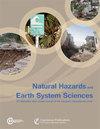不同构造背景下的地震地面运动建模及其不确定性:2020 年欧洲地震灾害模型 (ESHM20) 的挑战与应用
IF 4.2
2区 地球科学
Q1 GEOSCIENCES, MULTIDISCIPLINARY
引用次数: 2
摘要
摘要目前用于地震危险概率分析(PSHA)的强地动建模实践要求确定和校准适合应用区域内构造体系的经验模型,并对其已知和认识的不确定性进行量化。在开发 2020 年欧洲地震危险性模型(ESHM20)时,采用了一种基于区域化缩放骨干模型概念的地震动特征描述新方法,即在 PSHA 中确定一个合适的地震动模型(GMM),然后对其进行调整或应用缩放因子,以考虑相关区域基本地震学特性的认识不确定性。虽然区域化缩放骨干 GMM 概念的理论和发展已在之前的出版物中讨论过,但在最终 ESHM20 中的实施需要进一步完善三个区域的浅源地震 GMM:法国、葡萄牙和冰岛。对这些地区地球物理特征的探索以及对更多地动记录的分析促使对 GMM 逻辑树进行重新校准和/或对拟议的区域化进行修改。这些修改说明,ESHM20 GMM 逻辑树仍可根据新的地动数据和/或专家判断进行完善和调整,以适应不同地区的情况,而不会偏离所建议的区域化缩放骨干 GMM 框架。除了地壳地震区域,缩放-骨干方法还需要适应欧洲俯冲带和弗朗斯纳深震源区发生的地震。我们使用一种新颖的模糊方法,根据俯冲系统内不同的地震机制对地震进行分类,将非大陆地震的地动记录与现有的俯冲 GMM 进行比较,确定了一种适用于欧洲俯冲和深震源的骨干 GMM。通过观测中、小震级地震的地动记录,我们可以校准骨干 GMM 的无弹性衰减,特别是在地中海东部地区。然后,根据俯冲 GMM 的震源和衰减特征的全球变异性,对认识的不确定性进行校准。随着 ESHM20 的完成,我们反思了在区域尺度 PSHA 中实施这一新方法的经验教训,并强调了我们希望在未来几代欧洲地震危险性模型中看到地动特征描述的新发展和改进之处。本文章由计算机程序翻译,如有差异,请以英文原文为准。
Modelling seismic ground motion and its uncertainty in different tectonic contexts: challenges and application to the 2020 European Seismic Hazard Model (ESHM20)
Abstract. Current practice in strong ground motion modelling for probabilistic seismic hazard analysis (PSHA) requires the identification and calibration of empirical models appropriate to the tectonic regimes within the region of application, along with quantification of both their aleatory and epistemic uncertainties. For the development of the 2020 European Seismic Hazard Model (ESHM20) a novel approach for ground motion characterisation was adopted based on the concept of a regionalised scaled-backbone model, wherein a single appropriate ground motion model (GMM) is identified for use in PSHA, to which adjustments or scaling factors are then applied to account for epistemic uncertainty in the underlying seismological properties of the region of interest. While the theory and development of the regionalised scaled-backbone GMM concept have been discussed in earlier publications, implementation in the final ESHM20 required further refinements to the shallow-seismicity GMM in three regions, which were undertaken considering new data and insights gained from the feedback provided by experts in several regions of Europe: France, Portugal and Iceland. Exploration of the geophysical characteristics of these regions and analysis of additional ground motion records prompted recalibrations of the GMM logic tree and/or modifications to the proposed regionalisation. These modifications illustrate how the ESHM20 GMM logic tree can still be refined and adapted to different regions based on new ground motion data and/or expert judgement, without diverging from the proposed regionalised scaled-backbone GMM framework. In addition to the regions of crustal seismicity, the scaled-backbone approach needed to be adapted to earthquakes occurring in Europe's subduction zones and to the Vrancea deep seismogenic source region. Using a novel fuzzy methodology to classify earthquakes according to different seismic regimes within the subduction system, we compare ground motion records from non-crustal earthquakes to existing subduction GMMs and identify a suitable-backbone GMM for application to subduction and deep seismic sources in Europe. The observed ground motion records from moderate- and small-magnitude earthquakes allow us to calibrate the anelastic attenuation of the backbone GMM specifically for the eastern Mediterranean region. Epistemic uncertainty is then calibrated based on the global variability in source and attenuation characteristics of subduction GMMs. With the ESHM20 now completed, we reflect on the lessons learned from implementing this new approach in regional-scale PSHA and highlight where we hope to see new developments and improvements to the characterisation of ground motion in future generations of the European Seismic Hazard Model.
求助全文
通过发布文献求助,成功后即可免费获取论文全文。
去求助
来源期刊
CiteScore
7.60
自引率
6.50%
发文量
192
审稿时长
3.8 months
期刊介绍:
Natural Hazards and Earth System Sciences (NHESS) is an interdisciplinary and international journal dedicated to the public discussion and open-access publication of high-quality studies and original research on natural hazards and their consequences. Embracing a holistic Earth system science approach, NHESS serves a wide and diverse community of research scientists, practitioners, and decision makers concerned with detection of natural hazards, monitoring and modelling, vulnerability and risk assessment, and the design and implementation of mitigation and adaptation strategies, including economical, societal, and educational aspects.

 求助内容:
求助内容: 应助结果提醒方式:
应助结果提醒方式:


